The Burgess Shale
April 16, 2018
There are missed opportunities when
scientists are focused on their own field of
science to the exclusion of others.
Quantum mechanics is usually presented as a triumph of
physics, but its development had significant impetus from unanswered questions in
chemistry, especially the organization of the
periodic table.
Francis Crick, co-discoverer of the secret of life (more
prosaically, the
molecular structure of
DNA), started as a
physicist, but his fame arose from his further excursion into
molecular biology.
Luis Alvarez (1911-1988), who was awarded the 1968
Nobel Prize in Physics for his work in
elementary particle physics, is known also for the
hypothesis, co-authored with his son,
Walter Alvarez (b. October 3, 1940), that the
demise of the
dinosaurs was caused by a
meteor impact event.[1-2] He brought physics to bear on the problem through the use of
neutron activation analysis as a sensitive method for
trace element detection.
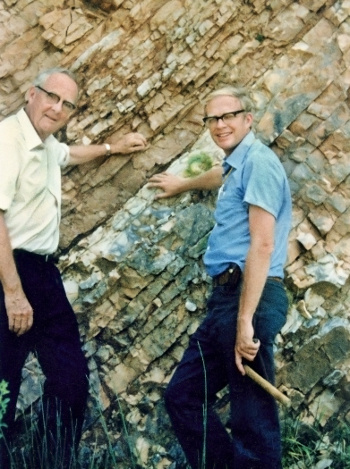
Luis Alvarez (left) and his son, Walter.
I wrote about this father-son team in a previous article (Near Earth Asteroids, October 5, 2011).
(Lawrence Berkeley Laboratory photograph, via Wikipedia Commons))
Iridium is a rare
element in
Earth's crust, existing as just 0.001
ppm by
weight, which is forty times less of an abundance than
gold. That's why its presence in the
clay layer that marks the
division between the Cretaceous and Paleogene Periods is unusual. While Earth does obtain about ten million
kilograms of iridium per year from the infall of
micrometeorites, it's distributed uniformly on Earth's surface, so the concentration in any one place should be very small.
The iridium concentration in this layer was at least two
orders of magnitude greater than expected. It's now believed that all this iridium came from the impact of an
asteroid, 10-15
kilometers (6-9
miles) in
diameter. The vestige of this impact is thought to be the
Chicxulub crater, centered on
Chicxulub, Yucatán,
Mexico. This crater is 150 kilometers (93 miles) in diameter and 20 km (12 miles) deep. Such an impact would have been a
natural disaster that caused most
species living at the time to become
extinct.
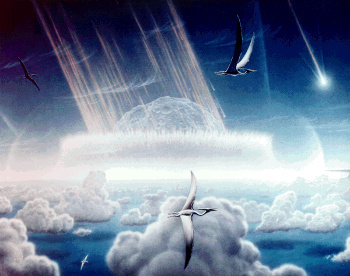
There goes the neighborhood!
While it may seem that the pteranodons in this image are flying quite high, there are some large modern birds that fly at tens of thousands of feet.
NASA image, photo P-45062, Chicxulub impact site by Donald E. Davis
As did most
students, I hated reading the books assigned by my
teachers. These were selected as being
classics in their respective fields of
literature and
history. It was only later that I discovered other books in these subject areas that were actually interesting to me. One of these was
economist Thorstein Veblen's,
The Theory of the Leisure Class.[3] In this book, Veblen writes about
conspicuous consumption, the purchase of
lavishly expensive, or
ephemeral and impractical,
goods and
services by
wealthy individuals as a display of their wealth. I wrote about this in an
earlier article (The Physics of Inequality, May 11, 2017).
Taking the example of many illustrious scientists, I endeavored to expand my reading beyond the
physical sciences. The
origin and
evolution of
life on Earth was especially interesting to me, since I had read as a
child a
magazine account of
Stanley Miller's 1953 experiment. In this experiment, Miller produced
amino acids, the
organic chemical precursors to life, from synthetic
lightning in a
flask containing
gases representative of Earth's early
reducing atmosphere (see figure). I wrote about this experiment in a
previous article (The Miller Experiment, July 30, 2014)
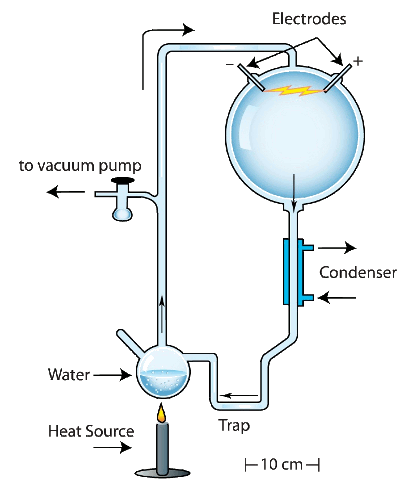
Schematic diagram of Stanley Miller's 1953 abiogenesis experiment.
Our present understanding of Earth's early atmosphere is that it was different from Miller's mixture. Instead of ammonia, methane, hydrogen and water, it was more like carbon dioxide, carbon monoxide, nitrogen, and water. Some hydrogen and methane would have come from volcanic sources, as would lightning.
(Modified illustration by Ned Shaw, Indiana University.)
A few million years after the first simple
organic chemicals appeared on Earth, chemical
complexity increased. There's
fossil evidence of this, as described in
Melvin Calvin's 1969 book,
Chemical Evolution.[4] As Calvin writes in the
preface to this book, "...there must have been a period of time in the earth's history that encompassed the transition between a non-living
molecular population on its surface and a population of molecular aggregates that we would call living." I wrote about Calvin's book in an
earlier article (Chemical Evolution, June 30, 2014)
The
fossil record in later years gives us a look at the simple
aquatic organisms flourished on the early Earth. One problem with fossil preservation of these early organisms is that they were composed mostly of
soft body parts, such as
legs,
gills, and
antennae, things that are quite impermanent. The
Burgess Shale Formation in
British Columbia is important to
paleontology, since its
shale preserved the soft body parts of these
animals.
While Burgess Shale has provided a wealth of
Middle Cambrian period fossils, such as those of the
trilobyte that I discussed in a
previous article (Trilobite Sex, March 13, 2017), there are many more fossil-bearing Burgess Shale-type deposits known worldwide.[5]
Geologists from
Yale University (New Haven, Connecticut), the
University of Oxford (Oxford, United Kingdom), and
Pomona College (Claremont, California) have identified a
mineral profile of which shale
compositions will yield fossils.[6-7]
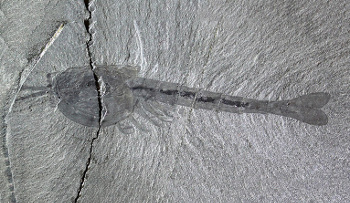
A fossil of Waptia from the Cambrian Burgess Shale Formation in British Columbia. The Waptia is shrimp-like creature about 5.5 centimeters long that lived about 508 million years ago.
(Yale University photo by Susan Butts.)
It's not surprising that the particular
chemical composition of shale, especially that of its precursor
clay minerals, will affect fossil preservation of soft body parts. The
research team did
powder X-ray diffraction crystallography of 213 Cambrian shales from 19
sedimentary successions on four
continents.[6-7] Their aim was the comparison of the shales that preserved soft tissues with those that only contained fossilized
shells or
skeletons.[7]
Logistic regression and
classification tree methods showed that soft body fossils are more likely to be found in those sediments that are rich in
berthierine/chamosite and poor in
celadonite and
illite. Such compositions are likely the result of a high
kaolinite/
smectite ratio in the original sediment, and the enhanced
iron concentrations affected the early
diagenesis (fossilization).[6] The mineral, berthierine, is
toxic to
decay bacteria.[7] Says study
coauthor, Oxford's
Ross P. Anderson,
"Berthierine is an interesting mineral because it forms in tropical settings when the sediments contain elevated concentrations of iron. This means that Burgess Shale-type fossils are likely confined to rocks that were formed at tropical latitudes and that come from locations or time periods that have enhanced iron."[7]
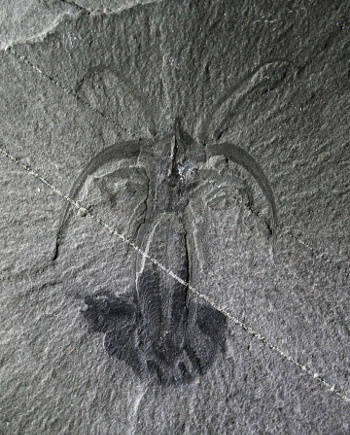
fossil of Marrella from the Cambrian Burgess Shale Formation in British Columbia.
The Marrella, which is a small arthropod less than 2 centimeters long that lived about 508 million years ago, is the most common fossil of that period.
(Yale University photo by Susan Butts)
Models derived from this analysis of clay mineralogy are able to predict fossil-bearing Cambrian shales with about 80%
accuracy.[6-7] Says
Derek Briggs, a
professor in the
Yale University Department of Geology & Geophysics, "This discovery is important because it will help us to narrow the search for exceptionally preserved fossils in thick sequences of Cambrian and
Precambrian rocks, which harbor critical clues to the early evolution of animal life on Earth."[7] The study may even aid in a search for possible fossil life on
Mars.[6-7]
Funding for this research was provided by the
NASA Astrobiology Institute, the
National Science Foundation, and other organizations.[7]
References:
- Frank Asaro, "The Cretaceous-Tertiary Iridium Anomaly and the Asteroid Impact Theory," Chapter 21 of Discovering Alvarez: selected works of Luis W. Alvarez, with commentary by his students and colleagues, University of Chicago Press, 1987, 272 pages (via Google Books); also available from Amazon.
- Luis W. Alvarez, "Experimental evidence that an asteroid impact led to the extinction of many species 65 million years ago," Proc. Natl. Acad. Sci., vol. 80, no. 2 (January 15, 1983), pp. 627-642; also available as a PDF file, here.
- Thorstein Veblen, "The Theory of the Leisure Class," 1.4 MB PDF File, via Law in Contemporary Society Web Site, Columbia Law School.
- Melvin Calvin, "Chemical Evolution," Oxford University Press, 1969, ISBN 0-19-855342-0, 278 pp. (via Amazon)
- Robert R. Gaines, Derek E.G. Briggs, and Zhao Yuanlong, "Cambrian Burgess Shale–type deposits share a common mode of fossilization," Geology, vol. 36, no. 10 (October 1, 2008), pp. 755-758, https://doi.org/10.1130/G24961A.1.
- Ross P. Anderson, Nicholas J. Tosca, Robert R. Gaines, Nicolás Mongiardino Koch, and Derek E.G. Briggs, "Mineralogical signature for Burgess Shale–type fossilization," Geology (February 15, 2018), https://doi.org/10.1130/G39941.1.
- Jim Shelton, "A mineral blueprint for finding Burgess Shale-type fossils, Yale University Press Release, February 15, 2018.
Linked Keywords: Scientist; science; quantum mechanics; physics; chemistry; periodic table; Francis Crick; prosaically; molecular structure; DNA; physicist; molecular biology; Luis Alvarez (1911-1988); Nobel Prize in Physics; elementary particle physics; Alvarez hypothesis; Walter Alvarez (b. October 3, 1940); extinction; demise; dinosaur; meteor impact event; neutron activation analysis; trace element; Lawrence Berkeley Laboratory; Wikipedia Commons; iridium; chemical element; Earth; crust (geology); parts-per notation; ppm; weight; gold; clay; division between the Cretaceous and Paleogene Periods; kilogram; micrometeoroid; micrometeorite; orders of magnitude; asteroid; kilometer; mile; diameter; Chicxulub crater; Chicxulub, Yucatán; Mexico; natural disaster; species; extinction; extinct; pteranodon; flight; flying; bird; foot (length); NASA image, photo P-45062; Donald E. Davis; student; teacher; classic book; classics; English literature; history; economist; Thorstein Veblen; The Theory of the Leisure Class; conspicuous consumption; cost; lavishly expensive; ephemerality; ephemeral; goods; service (economics); wealth; wealthy; physical sciences; abiogenesis; evolution; life; child; magazine; Stanley Miller; 1953 experiment; amino acid; organic compound; organic chemical; lightning; chemical reactor; flask; gas; reducing atmosphere; schematic diagram; Earth's early atmosphere; ammonia; methane; hydrogen; water; carbon dioxide; carbon monoxide; nitrogen; volcano; volcanic; Ned Shaw, Indiana University; complexity; fossil; Melvin Calvin; preface; molecule; molecular; fossil record; aquatic animal; aquatic organism; soft-bodied organism; soft body part; leg; gill; antenna (biology); Burgess Shale Formation; British Columbia; paleontology; shale; animal; Middle Cambrian period; trilobyte; geologist; Yale University (New Haven, Connecticut); University of Oxford (Oxford, United Kingdom); Pomona College (Claremont, California); mineral; chemical compound; composition; Waptia; Cambrian; shrimp; centimeter; Susan Butts; research; powder X-ray diffraction; crystallography; sedimentary rock; continent; shell; skeleton; logistic regression; classification tree method; berthierine/chamosite; celadonite; illite; kaolinite; smectite; ratio; iron; diagenesis; toxicity; toxic; decomposition; decay; bacteria; coauthor; Ross P. Anderson; tropics; tropical latitudes; geologic time scale; time period; Marrella; arthropod; centimeter; computer simulation; models; accuracy; Derek Briggs; professor; Yale University Department of Geology & Geophysics; Precambrian; Mars; Funding of science; NASA Astrobiology Institute; National Science Foundation.